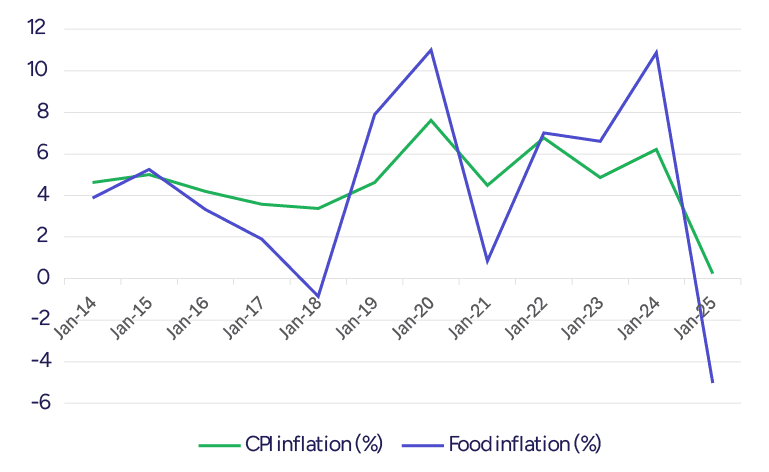India’s Retail Inflation Hits Record Low of 0.25% in October as Food Prices Slide and GST Cuts Take Hold
- 13th November 2025
- 12:00 PM
- 4 min read
Summary
India’s retail inflation eased to a record low of 0.25% in October 2025, down 119 basis points from September’s 1.44%, as GST cuts and lower food prices drove a broad-based decline, according to MoSPI. Core inflation rose slightly to 4.33%, led by higher gold and silver prices, while food items were 5% cheaper than a year ago.Mumbai | November 13
India’s retail inflation dropped to a historic low of 0.25% in October 2025, marking the lowest level since the Consumer Price Index (CPI) series was introduced. According to data released by the Ministry of Statistics and Programme Implementation (MoSPI), headline inflation fell 119 basis points from 1.44% in September, driven by a sharp decline in food prices, the full impact of recent GST rate cuts, and a favourable base effect.
The previous record low of 1.46%-recorded in June 2017, has now been surpassed twice, following September’s revised reading of 1.44% and the latest print for October. This continued softening highlights a rare phase of price stability across the Indian economy.
Food prices led the decline, with food inflation plunging to –5.02%, indicating that retail food items were, on average, 5% cheaper than a year ago. The fall was broad-based, covering vegetables, cereals, oils, fruits, and eggs. MoSPI attributed the steep fall to the combined impact of lower GST rates, a favourable base, and easing inflation across transport, footwear, and communication categories.

At the same time, core inflation (which excludes food and fuel) rose slightly to 4.33%, up from 4.26% in September and 3.65% a year earlier. The uptick was largely due to surging prices of gold and silver, with the two precious metals posting record inflation levels of 57.83% and 62.36%, respectively. This lifted the broader ‘miscellaneous’ category inflation to a 31-month high of 5.71%.
Rural inflation entered negative territory for the first time on record, with consumer prices 0.25% lower than a year ago. Urban inflation also cooled, easing to 0.88% from 1.83% in September.
The GST Effect
The reduction in Goods and Services Tax (GST) rates, implemented from September 22, had a significant dampening effect on prices. The GST Council’s decision to merge the earlier four-tier structure into two main slabs of 5% and 18%, with a 40% demerit rate for luxury and sin goods, led to a widespread drop in consumer costs-especially for everyday household and food items.
According to the Ministry’s statement, “The decline in headline and food inflation during October 2025 is mainly attributed to the full month’s impact of the GST cuts, favourable base effect, and a drop in inflation across oils and fats, vegetables, fruits, eggs, footwear, cereals, transport, and communication.”
The GST changes appear to have filtered through the retail chain effectively, supporting lower prices across most consumer categories. Economists note that the effect of these tax adjustments may continue to influence inflation readings in the coming months as businesses pass on more benefits to consumers.
Also Read: Next-Gen GST Reforms Boost Sectoral Sales, Says FM Nirmala Sitharaman
The Big Picture
India’s inflation trajectory in 2025 reflects one of the steepest disinflation phases in recent history. From 6.21% in October 2024 to 0.25% in October 2025, the drop marks a near six-percentage-point correction within a year driven by favourable supply conditions, fiscal adjustments, and stable fuel prices.
The Reserve Bank of India (RBI), which has maintained its policy repo rate at 5.5%, is expected to take note of the sustained softening. For FY26, CPI inflation has averaged 1.9% so far, below the RBI’s forecast of 2.6%. The central bank projects inflation to average 1.8% in the Oct–Dec 2025 quarter, before gradually rising to 4% by early 2026 as base effects fade.
Education inflation in October stood at 3.49%, health inflation at 3.86%, and fuel and light at 1.98%, all reflecting stability rather than pressure. Meanwhile, transport and communication inflation fell sharply to 0.94%, adding to the overall moderation.
India’s October inflation print underscores a unique moment of price calm, supported by policy alignment and easing market conditions. While food inflation remains negative and GST reforms have softened consumer costs, the long-term trajectory will depend on supply dynamics and the durability of tax pass-through.





